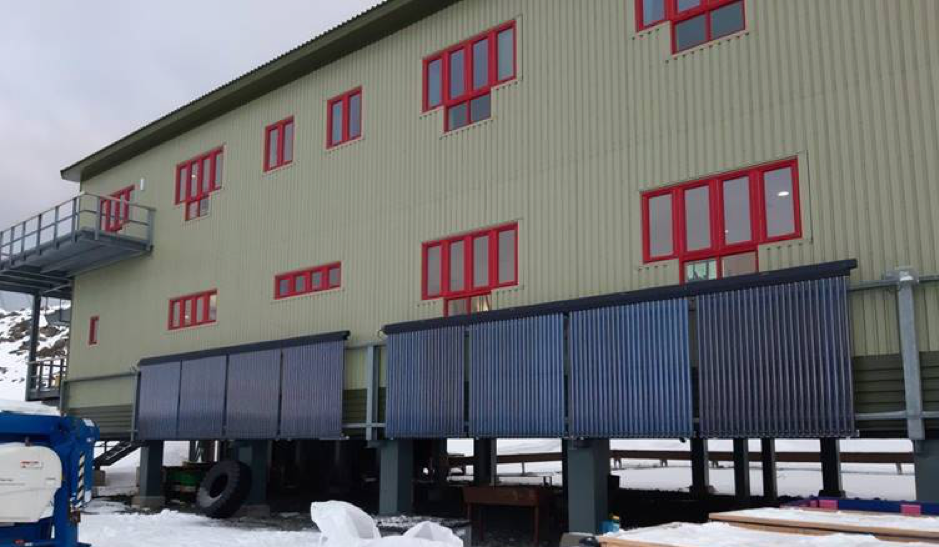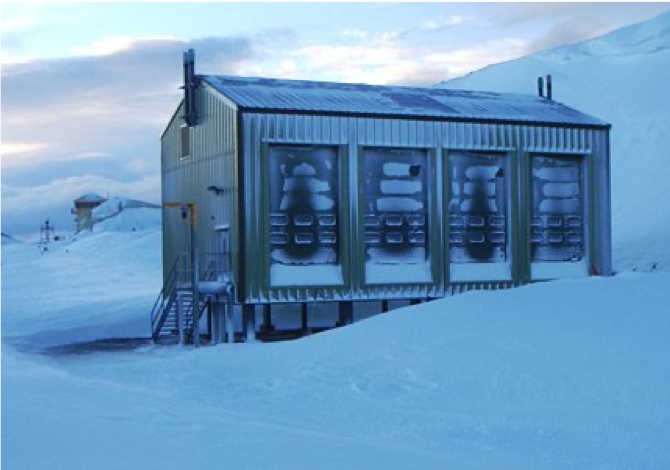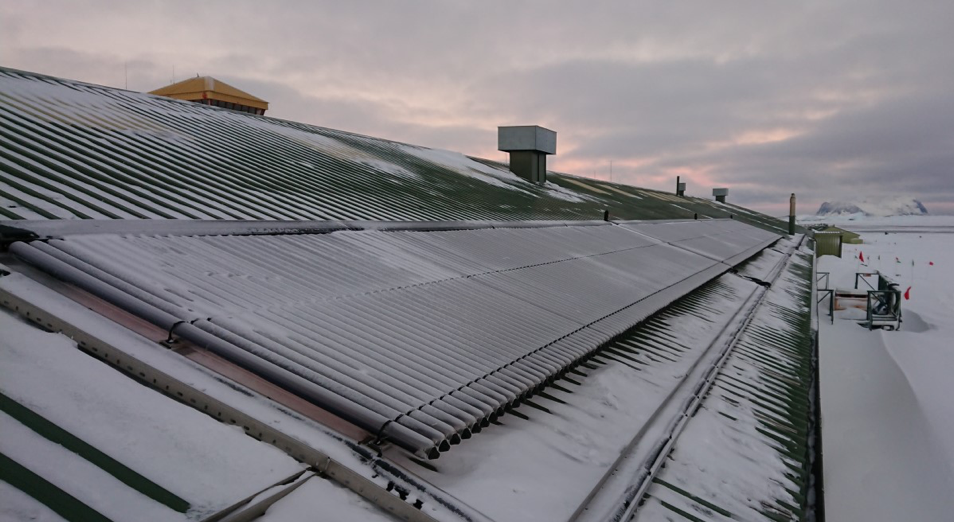Renewable Energy at Rothera Research Station
Maintaining a secure supply of energy at Rothera research station is critical in the upkeep of life support systems. The energy demand of the buildings at Rothera can be split into two key categories: electricity and heating. Heating is particularly important given the low temperatures in which the station operates. Traditionally both electricity and heat have been generated by fossil fuels; primarily marine gas oil (MGO). Over the past 15 years we have been introducing renewable energy to buildings across the station in the form of solar thermal and solar photovoltaics (PV). This is helping to increase the security of energy supply by reducing our reliance on fuel and is a step towards our target to decarbonise Rothera by 2030. Across the station we have installed a total of 92 kW of solar thermal energy and 8.77kWp of solar PV. This is estimated to save a total of 16 tCO2e every year.
NBH Solar Thermal
In 2019 we installed a solar thermal system of 38.7kW on the walls of New Bransfield House. The building is the main living block on the station and has a canteen, library and recreational facilities. This makes it one of the busiest and most power-hungry buildings on site in both summer and winter. The solar thermal array is made up of 8 Veissmann Vitosol 300-TM vacuum tube collectors with 24 tubes per collector covering an area of 37m2. It is estimated that the system provides almost 34% of the domestic hot water for the building and saves 4.1 tCO2e annually.

Gerritzs Lab PV
The Gerritzs Lab is a transportable laboratory facility in which a docking station houses four 20-foot high-cube containers, each of which contains a different laboratory which can be used as required and removed when necessary. In 2013, 8.77kWp of PV panels were installed on the Gerritzs Lab roof. The panels are positioned on both roofs with 67.5 m2 facing north and 31.5 m2 facing south in order to best use the 24-hour daylight at Rothera during the summer months. The panels are Hyundai HiS-S218SF units and generate on average 6270 kWh which is the equivalent of 0.4% of the total station electricity demand and saves 5.2 tCO2e annually.

Admirals Solar Thermal
In 2010, we upgraded the hot water system at Admirals house, introducing a large solar thermal array estimated to have a capacity of approximately 40kW. Admirals is an accommodation building constructed between 1999 and 2001, with maximum capacity of 88 people. The energy demand for hot water peaks in summer when there is a peak occupancy. Unlike previous solar thermal installations, the new panels incorporated direct panel temperature limitation which prevents overheating and subsequent damage to both the thermal store and panels. The system is made up of 3 banks of 4 Thermomax HP200 panels, with 120 evacuated tubes per bank. It is estimated that the system provides around 50% of the domestic hot water for the building. This will save just under 6 tCO2e annually.

Giants Solar Thermal
One of our oldest solar thermal arrays is on Giant’s house. Giant’s house is a transit accommodation block only used in summer. Originally erected in the 1996/7 season, it has a maximum capacity of up to 32 people. Installed in 2008 the system is made up of 12 Rayotec CPC 6 INOX solar panels with an estimated installed capacity of 13.1 kW. They consist of 6 evacuated tubes per panel, totalling 72 tubes. The system is estimated to save 0.7 tCO2e annually. This was one of our earliest renewable energy projects through which we understood the challenges of operating solar thermal in extreme conditions. Maximum temperature and pressure settings are used to protect the system from overheating during periods of high solar intensity.
Future plans on Rothera renewables
In order to decarbonise Rothera Research Station fully, a combination of renewable energy systems, including solar PV and wind turbines, together with different energy storage systems and a smart grid will be installed as part of the 10 year long Antarctic Infrastructure Modernisation Programme (AIMP). More information on the AIMP Rothera Renewables Project will be released in due course. Find out more about the Antarctic Infrastructure Modernisation Programme via this link.